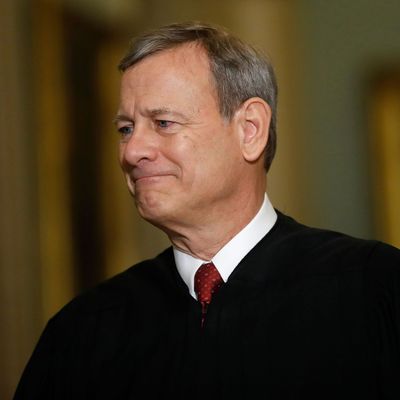
Without question, one of the highest stakes in the 2020 election is the president’s ability to make judicial appointments. It’s also not an issue voters often think much about. In 2016, however, Donald Trump succeeded in making the Supreme Court part of a potent appeal to a key segment of his party’s conservative base. This time around, he will likely do so again, and Democrats may try to convince voters that key constitutional rights will be lost if Joe Biden doesn’t nominate the next justice. But it’s a picture complicated by the Supreme Court term that just ended, which muddied the waters for both parties.
At this point in the last presidential election cycle, many conservatives looked at the Supreme Court and saw a lost cause. Almost exactly four years earlier, the Court had upheld Obamacare as constitutional in a surprise opinion written by Chief Justice John Roberts, a George W. Bush nominee. Almost exactly a year earlier, SCOTUS swept away prohibition of same-sex marriage in an opinion written by Justice Anthony Kennedy, a Ronald Reagan nominee. In February of 2016, conservative Court icon Antonin Scalia died, and all Republicans could do was fight off a replacement nomination by President Obama. And in June of 2016, in a 5-3 decision the Court repelled a whole series of state restrictions on abortion.
Conservatives knew the president elected in 2016 would get to appoint at least one Supreme Court justice, and probably more. A Hillary Clinton presidency might put the Court out of reach for years. But then, along came Donald Trump. A lot of conservatives didn’t particularly like the GOP’s presidential nominee, but Trump was willing to put aside all the traditional reticence about judicial independence and flat-out promise them the kind of Court they wanted.
In May of 2016, Trump became the first presidential candidate to release a list of eleven Supreme Court prospects from which he promised to select a replacement for Scalia, drawing on recommendations from the Federalist Society and the Heritage Foundation. In September, Trump expanded the list to 21 potential justices, including a smattering of more diverse jurists, and also a circuit court judge named Neil Gorsuch. In October, Trump publicly promised to appoint justices who would repeal Roe v. Wade and revoke the constitutional right to an abortion.
Trump’s highly transactional approach to his judicial appointments wound up being an important part of the process whereby he convinced cultural conservatives that his candidacy was a gamble worth taking. White Evangelical voters in particular were really fixated on the need to reverse abortion and LGBTQ rights, as McKay Coppins later noted in The Atlantic:
According to Election Day exit polls, one in five voters identified the Supreme Court as “the most important factor” in determining who they would pull the lever for. Many of those people were white Evangelicals who had winced at Trump’s rhetoric, cringed at his Biblical illiteracy, sighed at his less-than-holy personal life—and then voted for him anyway, believing that the next president’s most important responsibility was to replace Antonin Scalia with a conservative justice who would protect their religious freedom and fight abortion from the bench.
Trump kept his promises to the right by first appointing Neil Gorsuch and then Brett Kavanaugh to the Court, to the general approbation of conservative opinion-leaders and voters alike. But the payoff has been iffy at best.
During the recently concluded Supreme Court term, the conservative majority on the Court spectacularly failed to deliver a counter-revolution on abortion rights and LGBTQ equality. And as Vox’s Jane Coaston recently observed, it’s disappointing and angering some who had eagerly looked forward to something more radical:
What is the purpose of the Republican Party?
That’s a question some social conservatives have been asking following the Supreme Court’s ruling on June 15 in Bostock v. Clayton County, a major Supreme Court decision holding that federal law prohibits employment discrimination against LGBTQ workers — a decision written by Trump-appointed Justice Neil Gorsuch.
[The June 29] decision in June Medical Services LLC v. Russo, which found that a law requiring abortion providers to obtain hospital admitting privileges was unconstitutional, has only intensified that debate.
Both cases gave the Supreme Court the opportunity to prove to social conservatives that their faith in the Court — or, more accurately, in President Trump’s judicial nominations — was justified. Both cases saw those hopes dashed.
Gorsuch’s “betrayal” in Bostock was a particular shock to the cultural right, in part because so many of their leaders had hailed his ascent to the Court and in part because the decision was so flatly definitive. Speaking with Coaston, conservative religious writer Rod Dreher summed up the reaction thusly:
Every institution — the media, academia, corporations, and others — are against us on gay and transgender rights, and GOP lawmakers are gutless. The only hope we had was that federal judges would protect the status quo. Now that’s gone.
To be clear, Gorsuch and the other conservatives continued to carve out “religious liberty” protections for conservative Christians anxious to discriminate in hiring and employee benefits in the twin decisions of Our Lady of Guadalupe School v. Morrissey-Berru and Little Sisters of the Poor v. Pennsylvania. And in Espinoza v. Montana Department of Revenue the Court struck a blow for religious schools by killing off 19th-century bans on “sectarian” education funding. Overall, the Roberts Court has been as pro-business and anti-regulation as you might expect.
The chief justice’s central role in this term was perhaps its most striking feature: Roberts was in the majority in 98 percent of cases, and all 11 cases decided by 5-4 or 5-3 margins. That’s remarkable, according to the New York Times’ Adam Liptak, who pointed out last month that, “No chief justice has been in the majority in every closely divided case over an entire term since Chief Justice Charles Evans Hughes in the term that ended in 1938 — and that was in only four cases.”
Roberts is famously concerned about the Court losing its credibility if it develops a reputation for being politicized. And that may be one reason he has gone out of his way to avoid rubber-stamping Trump’s grandiose ideas of presidential power in cases ranging from an ideologically driven census question to a clumsy effort to kill protections for DACA recipients to the two cases ending the term wherein the Court rejected presidential claims of immunity from subpoenas.
Indeed, one theory, advanced by Dahlia Lithwick and Mark Joseph Stern, is that Roberts was deliberately trying to thwart the ability of Democrats to make Supreme Court appointments a big campaign issue:
The chief justice knows that both parties treat the court like a piñata, trying to convince their respective bases that they know how to smack the most candy out of it. He knows Democrats remain traumatized over Merrick Garland’s stymied appointment and Justice Brett Kavanaugh’s toxic confirmation. During the Democratic primary, multiple top-tier candidates pronounced themselves open to adding seats to the Supreme Court to counter Republicans’ judicial chicanery. Roberts also knows that a term filled with one conservative triumph after another would only have given Democrats ammunition to run against the court, framing it as a partisan institution in need of reform. That didn’t happen.
Democrats will nonetheless still try to make the Supreme Court a campaign issue, with the most persuasive argument being that however relatively tolerable this last term has been, giving Trump additional slots to fill on the Court could build a conservative majority so strong that Roberts couldn’t hedge its partisan bets even if he wanted to. The next two justices to leave the Court are likely to be its two octogenarian liberals, Ruth Bader Ginsburg (87) and Stephen Breyer (81). So another shift to the right is entirely possible if Trump wins reelection.
Furthermore, the cultural right’s stake in the Court remains salvageable. While the Bostock decision was a blow to conservative hopes to hold the line on LGBTQ rights, it was purely a statutory, not a constitutional, decision. In future rulings the Court could utilize the First Amendment to allow religious conservatives to discriminate with impunity. And Roberts’s opinion in June Medical Services was carefully written in a way that may open the door to future state restrictions on abortion providers that aren’t identical to those in that case.
Aware of these risks, a new progressive group has been formed to mobilize left-of-center voters around the threat to constitutional rights, as the Times reported earlier this month:
Known as Supreme Court Voter, the nonprofit advocacy project will start with $2 million in digital advertising in politically competitive states in attempts to mobilize voters around the idea that the long-term direction of the court — and the outcome of its rulings on hot-button policy and cultural issues — will be set for decades in the coming election.
Whether or not Democrats succeed in making the Supreme Court a campaign issue, Trump is clearly going to emphasize it again. He doesn’t have much choice. His response to the disgruntlement of conservatives with the Bostock and DACA cases was to echo it while renewing his pledge to reshape the Court in a second term:
He’s also promised to release a new Supreme Court prospect list before September 1, probably hoping to add a few more conservative Christian favorites and rebuild trust in his capacity to keep the counter-revolutionary judicial promises he made in 2016. It’s a token of how much the president believes in the power of this issue that he has reportedly longed for a retirement from Justice Samuel Alito and Clarence Thomas — his two staunchest allies on the Court — so he could wage a good, vicious, base-rousing Supreme Court confirmation fight before Election Day. Had that happened (it appears it won’t), there’s no question the Supreme Court would have been front and center in the presidential contest. As it is, it’s probably going to be just one of a number of topics where the outcome of the Biden-Trump battle will have stakes too high to exaggerate.






























